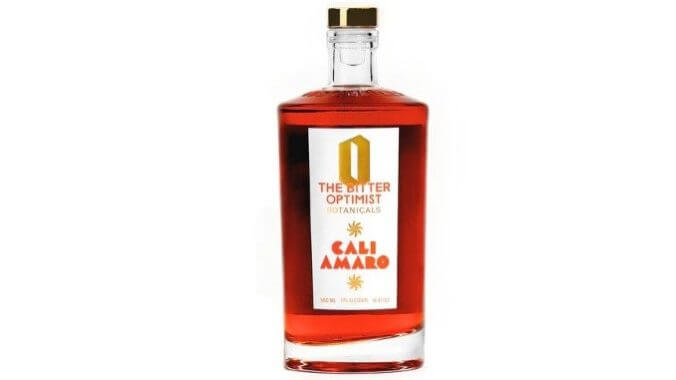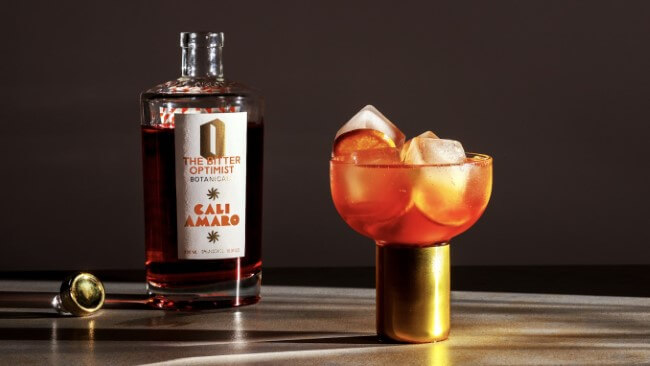The Bitter Optimist Cali Amaro
Photos via Optimist Botanicals
When it comes to the thriving, steadily growing market for non-alcoholic replacements for traditionally alcoholic beverages, I try to keep an open mind even when the ideas don’t always seem to bear fruit. In recent years, I’ve become a big booster for non-alcoholic craft beer styles in particular, which have rapidly improved in terms of their ability to offer an experience consistent with the real thing. My exposure to non-alcoholic wine is still limited, but I’ve tasted some that have been similarly eye opening.
But non-alcoholic spirits? It’s where I often still find myself drawing a philosophical line, though it’s not for a lack of trying. At this point, I’ve sampled quite a few tinctures and distillates trying to emulate various styles of alcoholic spirits, and none have really sparked recognition or satisfaction. I do believe that the “distilled non-alcoholic spirits with botanicals” route is the best one, because it yields a more honest product—one that is not specifically trying to emulate the flavors of a single style of alcoholic spirit, such as whiskey, or gin, or tequila. Products actually labeled as “non-alcoholic whiskey,” etc., have been the most disappointing and vile of the bunch, as their efforts to capture the texture and sometimes the “burn” of ethanol can verge on the disturbing.
The idea of “non-alcoholic amaro,” on the other hand … well, that’s sort of intriguing. By definition, amari are meant to be strongly flavored, bitter liqueurs, balancing the sharp and long-lasting bitterness of herbs such as gentian root with sweeter, fresher notes from other sources such as citrus fruits. They can be made with a wine base, or a base of distilled grain spirit, but it seems like the basic idea could also be interpreted in a non-alcoholic sense, albeit with a significantly thinner texture.
This is no doubt what the people at Optimist Botanicals were thinking when they cooked up their new The Bitter Optimist Cali Amaro. Described as being created for “those who enjoy an old school amaro or negroni,” Cali Amaro is a non-alcoholic take on the bartender favorite category, “crafted to be sipped straight over ice, as a spritz or as the base for a more complex cocktail.” It combines botanicals such as orange, pink grapefruit, mandarin, bay laurel, sage, wormwood, gentian and dandelion root to evoke the California landscape, and retails for $35 for a 500 ml bottle.

From the initial pitch, I was curious about this stuff, particularly in the sense of how the company might seek to balance sweetness/bitterness in the absence of alcohol. Sending in some questions, I got the following reply from Optimist Botanicals co-founder Tom Johnstone, who also said that products such as Amaro Angelino, Faccia Brutto and Leopold Brothers’s Aperitivo were amari that he and his distillers admired.
“The central challenge is getting the bitterness and the sweetness to work in harmony, and for us to include some botanical flavors authentic to California,” Johnstone said. “The backbone of the drink comes from 4 teas, one of them being gentian root which brings bitterness and body. We have a small amount of agave for sweetness and then some California citrus with pink grapefruit and mandarin round of the flavor.”
Curious to taste the Cali Amaro in its purest form, I poured a little over ice to start out. The nose was fresh, juicy and inviting—a bowl of oranges combined with more resinous tones and rosemary, along with hints of warm spice. Certainly, it evokes classic citrus aperitifs such as Aperol on the nose, though you can smell the bitter herbal and woody notes as well. And then I took a sip.
Good lord, folks.
I had just enough time to register the watery mouthfeel that non-alcoholic spirits almost inevitably possess before the first wave of bitterness crashed on my tongue, more or less folding my palate in on itself. Cali Amaro is astoundingly bitter on the palate, and the citrus vibrancy of the nose left me entirely unprepared for it. The dram is quite dry on its own, and the relative lack of sweetness means there’s nowhere at all to hide from the commanding bitterness—the woodiness and aggressive sensation just carries you along like a leaf in a roaring river, and it took me minutes to recover afterward.
And let it be known: I like amaro. I am a consumer who will happily nurse a little Montenegro, or Averna, or Nonino, which have a pleasant balance between bitter and sweet. But Cali Amaro has so little sweetness that drinking it neat gives in fully to the power of the herbaceous bitterness—it’s difficult for me to even imagine the consumer whose palate is so inured to the sensation that this wouldn’t strike them as overwhelmingly bitter. Wanting to recalibrate my sense of bitterness in general, I tasted a little neat Campari and confirmed that yes—it reads as much less bitter than Cali Amaro, because it has so much balancing sweetness.
Now, if I had stopped tasting The Bitter Optimist Cali Amaro at that point, I likely would have written it off as simply unpalatable. But wanting to give the drink a better chance to register on my taste buds without totally blowing them up, I decided to pair a small amount of the Cali Amaro with tonic water. Not wanting to overwhelm myself again, I got out a quarter teaspoon and began adding Cali Amaro to a small glass of tonic and ice, until it shone through in a way that was less all-encompassing.
And in this style of preparation? I was rather shocked to find that the Cali Amaro was honestly delightful. Added in very small quantities to the tonic water, which provided the necessary sweetness (in addition to its own mild bitterness from the quinine) to balance it out, the amaro imparted a very pleasant juiciness and floral quality, both of which were hard to perceive when tasting it on the rocks. A modest bitterness is carried through, making for a simple mixed drink that has structure and elegance.
This was truly a dramatic transformation, highlighting that the utility of a product ultimately comes down to how you’re using it. Some amari are simply too overwhelming for many consumers to drink all on their own, but cocktail components such as amaro or similarly bombastic flavors like absinthe can be key ingredients even in very small quantities. Half a teaspoon, or barspoon, might be all you need to radically change a flavor profile, or contribute bitterness.
With that said, the non-alcoholic component also presents some potential pitfalls, chief among them being that it’s recommended to consume the bottle within 2 weeks, lacking the preservative effects of alcohol. And with a spirit as intense and bold as Cali Amaro, it’s a bit difficult to imagine a home consumer managing to successfully use the entire contents of a bottle in only two weeks, unless they have a superhuman tolerance to bitterness, or are operating a busy bar out of the backyard. For a busy cocktail bar, however, I can see how a bottle of Cali Amaro could be a valuable weapon for crafting non-alcoholic cocktails with a genuine amaro punch.
Jim Vorel is a Paste staff writer and resident liquor geek. You can follow him on Twitter for more drink writing.